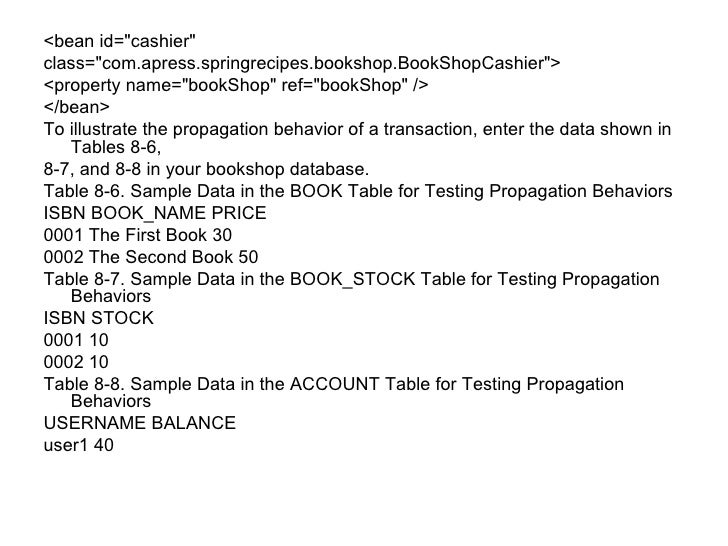
- SPRING TRANSACTION MANAGEMENT EXAMPLE HOW TO
- SPRING TRANSACTION MANAGEMENT EXAMPLE UPDATE
- SPRING TRANSACTION MANAGEMENT EXAMPLE DRIVER
Furthermore, Spring will perform some optimizations on the underlying JPA provider.
SPRING TRANSACTION MANAGEMENT EXAMPLE DRIVER
The readOnly flag instead is propagated as hint to the underlying JDBC driver for performance optimizations.
SPRING TRANSACTION MANAGEMENT EXAMPLE UPDATE
This will not, however, act as check that you do not trigger a manipulating query (although some databases reject INSERT and UPDATE statements inside a read only transaction). “It’s definitely reasonable to use transactions for read only queries and we can mark them as such by setting the readOnly flag. According to the documentation, if using hibernate as the JPA provider, when readOnly flag is set to true, flushMode on the Hibernate session will be set to NEVER, preventing any changes to data.įollowing is the excerpt from the spring data documentation which states this. So this is just a hint to the provider which in this case is hibernate. Spring doesn’t handle persistence, so it cannot define exactly what read-only should do. What happens when the read-only attribute is set to true? The next attribute I want to look at is readOnly, which is a boolean. REQUIRES_NEW - Create a new transaction, and suspend the current transaction if one exists.

If there is a transaction already started, then this method will execute within that, otherwise, a new one will be created. REQUIRED - Supports a current transaction, create a new one if none exists. These are the transaction propagation behaviours defined by the propagation enum. RuntimeExceptions triggers rollback, and any checked Exceptions do not.

The default timeout of the underlying transaction system, or to none if timeouts are not supported. Optional array of names of exception classes that must not cause rollback. Optional array of exception classes that must not cause rollback.Īrray of String class names, which must be derived from Throwable. Optional array of names of exception classes that must cause rollback. Optional array of exception classes that must cause rollback.Īrray of class names. Optional qualifier specifying the transaction manager to be used.Īrray of Class objects, which must be derived from Throwable. The following table from the documentation lists all of them. There are quite a few settings that can be applied to this annotation. For example, “start a brand new read-only transaction when this method is invoked, suspending any existing transaction”. The annotation is metadata that specifies that an interface, class, or method must have transactional semantics. In order to apply transaction management, all you have to do is add the annotation. So, you don’t have to do anything to enable transaction management. because I have spring-data libraries in the classpath, transaction management is enabled by the framework. We are building a Spring Boot application, so most of the configuration is done for me.

Typically transaction management is enabled using annotation or it could also be done via XML.
SPRING TRANSACTION MANAGEMENT EXAMPLE HOW TO
How To Enable Spring’s Transaction Management


 0 kommentar(er)
0 kommentar(er)
